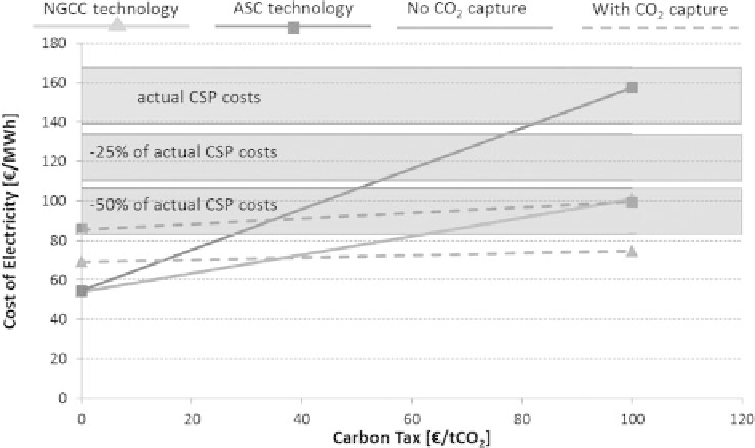Environmental Engineering Reference
In-Depth Information
Figure 14.6.2
Cost of Electricity [
a
/MWh] for different solar field costs; reference cases with COE as
function of the carbon tax is also shown.
Solar One case are about 2300
/kW
net
higher than ASC and NGCC cases. This is a
consequence of solar field costs as well as limited power output (50 MW): CSP suffers
from a small-scale power section compared to conventional fossil-fuel plants, with
drawbacks from an economic point of view. As a term of comparison, fossil fuel-based
plants have a net power output between 750 and 850 MW, which is more than 10
times larger than the typical CSP size, with scale-up cost advantages. With regard to
Fresnel technology, the equivalent cost should be about 45-50% lower than parabolic
trough. This level of cost saving might be achieved as a consequence of improved
receiver and tracking systems, cheaper mirrors and structure. Moreover, the inves-
tigated LFR has a concentration ratio twice that of PT, reducing absorber-specific
costs.
The same analysis could also be carried out on the power tower system, how-
ever the overall results would show no change since the system has yet to show
economic benefits to match PT, and it shares some negative aspects with the linear
focus technology in having a small-scale power section.
Turning to CSP plants, assuming technological improvements of the solar field
and thermal storage system, this could bring cost reductions of between 25% and
50% of current prices. No cost variation is assumed for the power section as this is a
mature technology and the only significant breakthrough can come from scaling up.
In addition, the cost of electricity is reported as a function of carbon tax price (
a
/t
CO2
).
a
The results of this analysis are summarized in Figure 14.6.2.
The COE bandwidth considers the resulting cost of electricity set against the two
different sets of assumptions (Morin et al., 2012; A. Giostri et al., 2013). This analysis

Search WWH ::

Custom Search